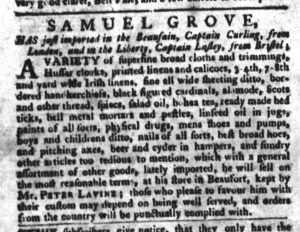What was advertised in a colonial American newspaper 250 years ago today?

“At his store in Beaufort.”
Samuel Grove advertised imported textiles and “a general assortment of other goods” in the January 5, 1768, edition of the South-Carolina Gazette and Country Journal. Unlike most of the merchants, shopkeepers, and artisans who advertised in that newspaper or its local competitors, Grove’s business was not located in Charleston. Instead, he owned a store in Beaufort, “kept by Mr. PETER LAVINE.” Grove’s advertisement testifies to the reach of both consumer culture and print culture, especially the distribution of newspapers, in eighteenth-century America.
Chartered in 1711, Beaufort is located on Port Royal, one of the Sea Islands in the South Carolina Lowcountry, approximately midway between Charleston and Savannah. The town did not have its own newspaper; instead the newspapers printed in Charleston served the residents of Beaufort and the rest of the colony. According to Edward Connery Lathem’s Chronological Table of American Newspapers, South Carolina’s newspapers were published exclusively in Charleston until the appearance of the South-Carolina Gazette in Parker’s Ferry in 1782, just as the revolution neared its end.[1] Only one issue survives, though items reprinted in other newspapers suggest that the Parker’s Ferry South-Carolina Gazette commenced in April and continued at least until the end of June.[2] No other newspaper printed beyond Charleston appeared until James Carson published the South-Carolina Independent Gazette in Georgetown, also in the Lowcountry, in 1791.[3] In the interim, a variety of newspapers commenced (and many of them ceased) publication in Charleston. The colony’s oldest city remained the primary hub for disseminating information, both news and advertising, for a quarter century after Samuel Grove inserted his advertisement for a store in Beaufort in Charleston’s South-Carolina Gazette and Country Journal. He placed that advertisement with confidence that prospective customers in Beaufort would see it. In addition, he realized that readers in other parts of the country would also encounter it. To that end, he accepted “orders from the country” beyond Beaufort.
Charleston’s newspapers served an extensive hinterland. Samuel Grove turned to the advertising pages of one of those newspapers to attract customers who resided in that hinterland.
**********
[1] Edward Connery Lathem, Chronological Tables of American Newspapers, 1620-1820 (Barre, MA: American Antiquarian Society and Barre Publishers, 1972), 21.
[2] Clarence S. Brigham, History and Bibliography of American Newspapers, 1690-1820 (Worcester, MA: American Antiquarian Society, 1947), 1052.
[3] Lathem, Chronological Tables, 40
